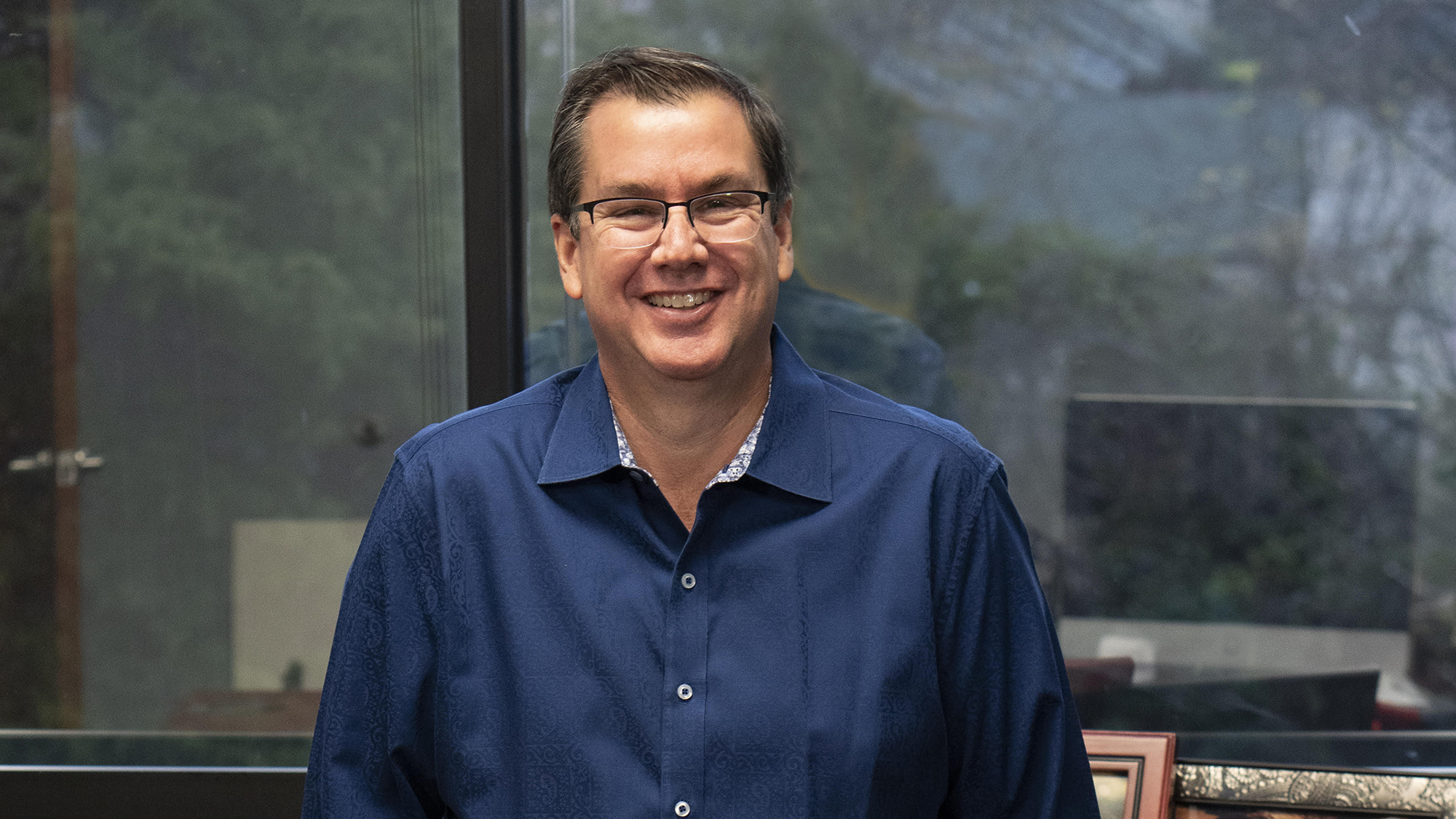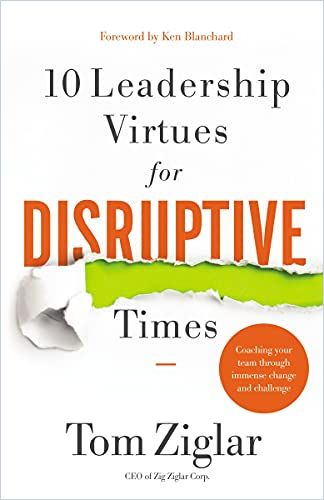“If Our Value Is Growth, Then I Love Disruption.”

Tom, as an executive coach you know that disruption is the topic business leaders are most worried about. In your book 10 Leadership Virtues for Disruptive Times, you talk about reimagining the workplace in the wake of the pandemic. What has changed for organizations and employees?
A couple of big shifts happened. When the pandemic came, people went home and hybrid work or remote work became more common. But the biggest shift is people’s priorities changed. We’ve all lost someone or had somebody close to us get very ill and for many millions of people, their work was up in the air. Will I even have a job? A lot of people discovered that they could be effective from home or in a hybrid situation. Many people moved.
Before the pandemic, everything revolved around work: our family, our relationships, our health. And then, all of a sudden, we go home and we have more time with those we love. People started working out more. They got to pick their schedule. I read somewhere that Etsy had millions of people start a side business.
Sure.
So now they’re making half what they made at the 8 to 5 corporate job in their side job. But they got their life back, and they don’t have to buy clothes, and they don’t have to pay for transportation, and they get to live and hang out closer to their family and friends and people they love. So people’s priorities shifted. We see that reflected in the phrase “quiet quitting” or “the great resignation.”
You also talk about employees looking for a higher purpose.
Yes. When life became uncertain, people realized that they wanted to make sure their life mattered. They wanted to work towards something that created purpose in their life. One thing led to another and they started being more intentional in what they did.

Even with an emphasis on creating a better work/life balance, do you find people are just as driven as ever to be top performers?
That’s what we’re trying to figure out right now in the work environment, because the quiet quitters are saying, “Okay, you’re making me come back to the office so I’m going to do just enough to keep my paycheck.” Top performers, on the other hand, if they find an organization that fulfills their purpose, they believe in the higher cause, the problem that that organization solves, then the leadership there makes the quality of life a core objective. The number one issue in large companies today is the mental health and well-being of their people.
Big companies understand if people are unhappy, if they’re depressed, if they’re not motivated, if they’re stressed and burnt out, they’re not going to perform. So there’s this vested interest in quality of life equals quality of work.
Tom Ziglar
With people leaving the workforce and being selective in what they want to do, and 11 and a half million available jobs and five and a half million people looking, that puts an emphasis on top performers. If you’re a top performer, you get to pick where you work now and who you work with. If you want to work remotely, there are companies hiring only remote people. It costs 20 to 30% less to hire a remote person. People will work with an organization that’s flexible on scheduling. It doesn’t work for every career path, but for a lot it does. So now leaders really need to focus on outcomes rather than outputs. An outcome is: what’s the end result we want in the relationship with that customer? Output is more like: how many calls did you make today?
What’s the goal of the coaching approach to develop top performers?
Coach leaders choreograph the dance between autonomy and authority. Team members want autonomy. So that’s where the company says, “Hey, when do you want to work in the office?” But then you’ve got to balance that with authority, which means if I’m a leader and I’ve got ten people on my team and a project deadline and a customer that’s depending on how we work together, it’s like herding cats. How do we give everybody autonomy and have this authority? I use Navy SEALs as an example. Navy SEALs are not only the best trained, but also the most trained group of people in the world. They are constantly learning. They’re constantly growing. It’s just their heartbeat. But when something comes in, the leader says, “Here’s the mission, get it done. How can I help?” That’s what we want in business, right? We want to tell our people: “here’s the mission, get it done, what do you need?” But we forget there is a massive amount of training and development and the support of growth in their people. That’s where the coach leader comes in. Coach leaders understand that we value growth in our people as much and really even more than results.
If I am results-focused and the world changes and my people haven’t grown to handle the change, then we’re done.
Tom Ziglar
But if our value is growth, then I love disruption because we’re a learning organization. We’re always growing. The more disruption there is, the more two things happen: there are more people to serve, and we have a competitive advantage. As a coach leader, I’m growth-focused and all about learning.
How is a “coach leader” different from a traditional leader?
Traditional leaders take a top-down, command and control, “do it because I said so” approach. Now what happened in the pandemic is we lost body language. Most communication is body language. On a camera, you lose that. So the traditional “T-Rex leader” – sharp teeth, because they bite your head off, short arms because they like control – they lost their influence and ability to lead through the camera. They might be really good people in general, and when you’re in a room with the rest of the team, there are other people on the team who will say, “Well, you know what they really mean. You know he or she really values you. They’re just rough around the edges.” Well, you lose all that when you’re leading a remote group or a hybrid group.
Take-Aways:
- Disruptive times call for a “coach leader,” someone who co-creates a plan of action with employees and protects their quality of life while aligning their goals with the organization’s purpose.
- A coach leader asks questions rather than barks orders and aims for continuous growth to keep up with continuous change.
- A coach leader is inclusive, and leads with kindness and respect.
And what does work?
It’s the coach leader who’s focused on growth, who co-creates plans, who’s all about asking questions instead of giving orders, who’s all about protecting someone’s quality of life and guarding against stress and burnout and depression and lack of motivation. That’s what a coach leader does. It’s not just what did you do for me yesterday. It’s how much more effective are you as an individual tomorrow than you are today. And I want to help you get there. Co-creation is the key. A traditional leader might ask, “do you want a promotion?” “Well, yes, I do.” “Okay, here’s the job description. You know what to do.” A coach leader might say, “Hey, do you want to make more money? Do you want to be promoted?” “Well, yes, I do.” The coach leader would ask, “What attitudes are you going to develop in yourself and demonstrate that will help you become more effective in your job role?” It’s all about questioning. When you ask questions, it reveals a lot about that person. Sometimes you’ve got a very sophisticated ten-year team member who knows exactly what they need to work on. And when they say it in their own words, they have ownership. Now you can hold them accountable to their own plan, which is powerful.
Yes, it is powerful.
If they’re green or don’t have a clue, then you can start asking more questions to help them reveal what they don’t know. And then they say, “Maybe I should work on that.” And you say, “That’s fantastic. I’m glad you said that.” Guess what? Now they’ve got ownership.
How does a coach leader help someone who is perhaps not embraced by corporate culture: women, people of color or people of a different religious background, for instance?
I have a coach to help with diversity, equity and inclusion (DEI), to be sure I’m using language that everyone buys into; I don’t want to be off-putting in any way unintentionally. Her name is Michelle Delgado, and she described her first job where everyone on her team fought over job assignments and promotions, but she didn’t because that wasn’t a part of her culture. She’s Puerto Rican and female, and she felt the leader should know what she’s good at and assign projects and should recognize her contributions. But after a few years, she’s being paid less than the people she started out with because she isn’t getting access to the assignments that lead to promotions. She’s not meeting other key leaders and building her network. If you’re not getting the raises you deserve, over time that equals hundreds of thousands of dollars lost by the end of your career.
So how does a coach leader help that person feel included?
On the very first day on the job, a coach leader comes to you and says, “At the end of the year, do you want to be making more money, the same money or less money? Would you like to be eligible for promotion?” And the person says, “Yes, I want to make more money.” I’d say, “Well, my job is to help you make more money and to get you that promotion. But I can only do that if you’re more effective for the business in a year than you are today, and you contribute to the profit and growth of the organization. Does that sound fair?” “Yes.” “Then let’s put a plan together. How can you become more effective in your attitude? What skills do you need to learn that will improve your effectiveness in your job role?”
So you’re both on the same page with a plan. That makes sense.
I’ll be honest with you, I’m an introvert, I’m a people pleaser and I’m not going to fight for a raise. I’m not going to fight for a project. It’s just not who I am. Without even realizing it, some of the most qualified people from all different backgrounds are slipping through the cracks. Coach leaders bring everybody in. It’s about growth and becoming more effective tomorrow than you are today. Then you’re able to say, “Is it okay if I hold you accountable to your own plan?”
I can see how this approach engages employees and give them buy-in, but on their terms, which is really marvelous. And it comes back to emphasizing quality of life.
One of my friends, Rabbi Daniel Lapin, said the opposite of depression is not happiness, it’s purpose. What a coach leader does is connect people to the purpose of the organization, the why.
You speak about aligning dreams and purpose…
Coach leaders say it every day: this is the difference we make. And then they also find out what that individual’s purpose is. Why are you working here? Is it to get out of debt? Is it to build your dream home? Is it to put your kids through college? When you align those – the better I do, the faster I get my dreams – the company also wins. Where does motivation come from? It comes from growth. If I’m growing, then I’m getting better. I’m becoming more competent. Competence creates confidence. Confidence is self-motivation.
Why would I ever leave a place where my coach leader is helping me grow towards my purpose and is protecting my quality of life?
Tom Ziglar
In your book, you emphasize several character virtues for successful coach leaders, and you start with kindness. Why is kindness such a key virtue in leadership?
Everybody says, “Love your people” but nobody tells you how. One of the ways you love your people is you’re kind to them. Is it kind to send somebody a text at 4:45 AM or an email at 11 at night? As a leader, that’s not kind. One of the ways we can demonstrate kindness as a core value is to show respect. Any time you have a meeting, you just lay out, hey, we’re going to treat each other with respect. It’s unkind not to respect someone. When somebody steps over the line or gets in a gray area, the leader calls time out and talks with that person, one on one. When kindness and respect become part of the way we communicate, that’s a pretty fun place to work, right? I agree with Shaunti Feldhahn. She said that kindness is a super-secret power. If we can have one virtue that makes every other one possible, it just might be kindness.
You also talk about grit, especially when facing crises. What’s a good strategy to help people persevere through tough times?
I call this “the middle of the night.” You know, you wake up in the middle of the night and you can’t sleep. Disruption is everywhere. The business is at risk. Your career is at risk. So what do you do? We’ve got to persevere. We’ve got to have grit. So we go through a process. One of the things that we’ve got to do is understand what we are telling ourselves.
The most powerful story in the world is the story you tell yourself.
Tom Ziglar
As a coach leader, we love disruption. We love the change and challenge. When your team sees that you live for disruption, it changes the atmosphere. So, the story we tell ourselves as a coach leader is that we’re learning and growing as an organization and team. That’s our strength. That’s how we get ahead. I love it when a new app gets released or a competitor comes into our market or inflation goes up or a mortgage crisis comes along, or whatever. We love that around here. Why? Because there’s more people we can serve, and we learn, and grow and adapt. You embody that story and your team sees we’re going to get through this. We’ll figure it out together. But it does take grit to do that, because it’s no fun in the quicksand while you’re going through it. So we prepare for that before it happens.
That’s the training you were talking about.
Right, that’s the training. That’s the expectation. That’s letting your team know every week, “We’re doing great but we can always improve and we’re going to look at, no matter how good it is, what we can do differently and better. And it’s going to be different next week. I don’t know what the change is going to be, but you know there’s going to be change. And that’s what I live for because you guys learn and grow faster than anybody I’ve ever worked with.” That’s the message.
About the Author
Author Tom Ziglar is the CEO of Ziglar, Inc., founded by his father Zig Ziglar, an executive coach, and author of 10 Leadership Virtues for Disruptive Times and Choose to Win.
Related Channels:






